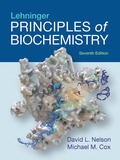
Concept explainers
(a)
To calculate:
The hydrogen ions concentration in external medium and in matrix if the
Introduction:
Protons are translocated to external medium from mitochondrial matrix. This results in establishment of
(a)
Explanation of Solution
Explanation:
The
The concentration of
The concentration of
Conclusion:
The concentration of
(b)
To calculate:
Outside to inside ratio of
Introduction:
The concentration of hydrogen ions reflects
(b)
Explanation of Solution
Explanation:
The concentration of
The ratio of the hydrogen ions concentration in the external medium and matrix can be calculated using the following formula:
Substitute values of hydrogen ions concentration in the external medium and hydrogen ions concentration in the matrix. The ratio of the concentration of hydrogen ions in the external medium and matrix is as follows:
Free energy inherent in this concentration difference can be calculated using the following formula
Where,
R is gas constant
T is absolute temperature
Substitute values of C2 and C1 in the above equation. The inherent energy of the reaction will be as follows:
Negative sign of free energy reflects that the inner transmembrane potential is negative. So energy inherent in the concentration difference is
Conclusion:
Energy inherent in the concentration difference is
(c)
To calculate:
The number of protons in actively respiring mitochondrion of liver given that diameter is
Introduction:
The number of protons in respiring mitochondria depends on the volume of the mitochondrion. More the diameter of mitochondrion, more will the protons liberated by it.
(c)
Explanation of Solution
Explanation:
The diameter of the mitochondrion is
Where, π is
r is radius of mitochondrion
Substitute value of r in the formula given above to calculate the volume of mitochondrion. The volume of mitochondrion can be calculated as follows:
Moles of protons in a respiring mitochondrion can be calculated by the following formula:
Substitute value of
Number of protons in a respiring mitochondrion can be calculated by using the following formula:
So, the number of protons in the respiring liver is
Conclusion:
So, the number of protons in the respiring liver is
(d)
To predict:
Whether the
Introduction:
The protons are transported from the matrix to external medium. This creates a proton gradient across the inner mitochondrial membrane. The flow of proton from external matrix into matrix derives the synthesis of ATP.
(d)
Explanation of Solution
Explanation:
For an actively respiring cell, energy inherent in the concentration difference is
Conclusion:
The free energy of the difference in the concentration of hydrogen ions in external medium and matrix is
(e)
To suggest:
The way through which necessary energy is provided by ATP synthesis.
Introduction:
The protons are transported from the matrix to external medium. This creates a proton gradient across the inner mitochondrial membrane. The flow of proton from external matrix into matrix derives the synthesis of ATP.
(e)
Explanation of Solution
Explanation:
The concentration gradient is not alone enough for driving the synthesis of ATP. So, the sum of energy generated by charge separation and concentration gradient is used to drive the synthesis.
Conclusion:
The overall transmembrane electric potential is developed by concentration gradient and charge separation which together drive the synthesis of ATP.
Want to see more full solutions like this?
Chapter 19 Solutions
EBK LEHNINGER PRINCIPLES OF BIOCHEMISTR
 ChemistryChemistryISBN:9781305957404Author:Steven S. Zumdahl, Susan A. Zumdahl, Donald J. DeCostePublisher:Cengage Learning
ChemistryChemistryISBN:9781305957404Author:Steven S. Zumdahl, Susan A. Zumdahl, Donald J. DeCostePublisher:Cengage Learning ChemistryChemistryISBN:9781259911156Author:Raymond Chang Dr., Jason Overby ProfessorPublisher:McGraw-Hill Education
ChemistryChemistryISBN:9781259911156Author:Raymond Chang Dr., Jason Overby ProfessorPublisher:McGraw-Hill Education Principles of Instrumental AnalysisChemistryISBN:9781305577213Author:Douglas A. Skoog, F. James Holler, Stanley R. CrouchPublisher:Cengage Learning
Principles of Instrumental AnalysisChemistryISBN:9781305577213Author:Douglas A. Skoog, F. James Holler, Stanley R. CrouchPublisher:Cengage Learning Organic ChemistryChemistryISBN:9780078021558Author:Janice Gorzynski Smith Dr.Publisher:McGraw-Hill Education
Organic ChemistryChemistryISBN:9780078021558Author:Janice Gorzynski Smith Dr.Publisher:McGraw-Hill Education Chemistry: Principles and ReactionsChemistryISBN:9781305079373Author:William L. Masterton, Cecile N. HurleyPublisher:Cengage Learning
Chemistry: Principles and ReactionsChemistryISBN:9781305079373Author:William L. Masterton, Cecile N. HurleyPublisher:Cengage Learning Elementary Principles of Chemical Processes, Bind...ChemistryISBN:9781118431221Author:Richard M. Felder, Ronald W. Rousseau, Lisa G. BullardPublisher:WILEY
Elementary Principles of Chemical Processes, Bind...ChemistryISBN:9781118431221Author:Richard M. Felder, Ronald W. Rousseau, Lisa G. BullardPublisher:WILEY





